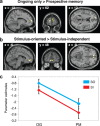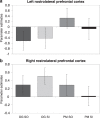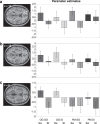Rostral prefrontal cortex and the focus of attention in prospective memory
- PMID: 21976356
- PMCID: PMC3388891
- DOI: 10.1093/cercor/bhr264
Rostral prefrontal cortex and the focus of attention in prospective memory
Abstract
Prospective memory (PM) denotes the function to realize intentions after a delay while being immersed in distracting ongoing (OG) activity. Here, we scrutinize the often-reported involvement of rostral prefrontal cortex (rPFC; approximating Brodmann area 10) in such situations: This region might mediate attention between external stimuli and the internally maintained intention, that is, between stimulus-oriented (SO) and stimulus-independent (SI) processing. Using functional magnetic resonance imaging (fMRI) we orthogonally crossed 1) PM versus OG activity only, with 2) SO versus SI attention. In support of the hypothesis, common regions of medial rPFC exhibited greater blood oxygen level-dependent (BOLD) signal for the contrasts of both OG task only versus PM and SO versus SI attending. However, activation related to the former contrast extended more superiorly, suggesting a functional gradient along a dorsal-ventral axis within this region. Moreover, region-of-interest analyses revealed that PM versus OG task only was associated with greater BOLD signal in left lateral rPFC, reflecting the requirement to maintain delayed intentions. Distinct aspects of this region were also transiently engaged at transitions between SO and SI conditions. These results are consistent with the hypothesis that some of the rostral prefrontal signal changes associated with PM performance reflect relative differences in SO versus SI processing.
Figures






References
-
- Amodio DM, Frith CD. Meeting of minds: the medial frontal cortex and social cognition. Nat Rev Neurosci. 2006;7:268–277. - PubMed
-
- Barbas H, Ghashghaei H, Dombrowski SM, Rempel-Clower NL. Medial prefrontal cortices are unified by common connections with superior temporal cortices and distinguished by input from memory-related areas in the rhesus monkey. J Comp Neurol. 1999;410:343–367. - PubMed
-
- Benoit RG, Gilbert SJ, Volle E, Burgess PW. When I think about me and simulate you: medial rostral prefrontal cortex involvement in self-referential processes. Neuroimage. 2010;50:1340–1349. - PubMed
Publication types
MeSH terms
Grants and funding
LinkOut - more resources
Full Text Sources
Medical
Molecular Biology Databases
Miscellaneous

